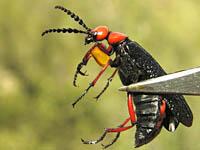show/hide words to know
Excrete: an important process for all animals that involves the removal of waste materials from the blood, tissues and organs.
Haemolymph: a free flowing fluid found in open spaces surrounding cells that often works like blood for many invertebrates such as insects and spiders.
Manufacture: to make something.
Predator: an animal that eats other animals to survive. For example, a lion is a predator... more
A Brief Story of Insect Blood
The blood or haemolymph of blister beetles is similar to that of other insects in that it contains nutrients (taken from the food that the beetles eat) that are carried around to the various organs within the beetle's body where they are used to run the internal parts of the bug. The organs also dump their waste products into the blood, which carries them to a special organ that removes these unwanted materials so they can be excreted by the beetle.
What's so Bad About Blister Beetle Blood?

Chemical structure of cantharidin. (image from wikimedia)
The blood of blister beetles is unusual in that it contains the chemical cantharidin, a very toxic, nasty chemical that protects the beetle from some animals that would kill and eat the insect. Males manufacture their own cantharidin in large amounts but females cannot make their own protective chemicals. Females do not need to do so because when they mate, the male transfers his cantharidin to his mate, which she then gets to use for herself and also to cover her eggs to protect them from being eaten by predators.
Besides blister beetles, there are a few other insects that make cantharidin. The false blister beetles and the cardinal beetles have cantharidin in their haemoloymph. All of these insects are great to observe, but should not be touched.
View Citation
Bibliographic details:
- Article: Blister Beetle Blood
- Author(s): John Alcock
- Publisher: Arizona State University School of Life Sciences Ask A Biologist
- Site name: ASU - Ask A Biologist
- Date published: May 19, 2017
- Date accessed: April 17, 2024
- Link: https://askabiologist.asu.edu/blister-beetle-blood
APA Style
John Alcock. (2017, May 19). Blister Beetle Blood. ASU - Ask A Biologist. Retrieved April 17, 2024 from https://askabiologist.asu.edu/blister-beetle-blood
Chicago Manual of Style
John Alcock. "Blister Beetle Blood". ASU - Ask A Biologist. 19 May, 2017. https://askabiologist.asu.edu/blister-beetle-blood
John Alcock. "Blister Beetle Blood". ASU - Ask A Biologist. 19 May 2017. ASU - Ask A Biologist, Web. 17 Apr 2024. https://askabiologist.asu.edu/blister-beetle-blood
MLA 2017 Style

Be Part of
Ask A Biologist
By volunteering, or simply sending us feedback on the site. Scientists, teachers, writers, illustrators, and translators are all important to the program. If you are interested in helping with the website we have a Volunteers page to get the process started.








